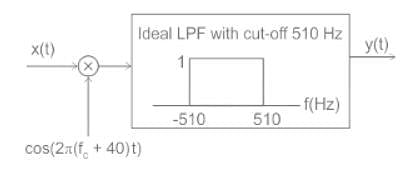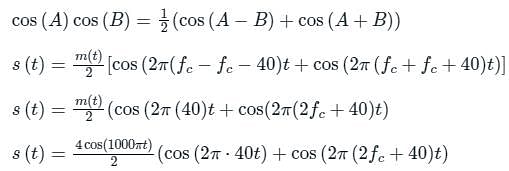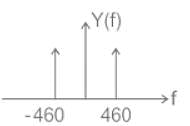Electronics and Communication Engineering (ECE) Exam > Electronics and Communication Engineering (ECE) Questions > For the modulated signal x(t) = m(t) cos (2&p...
Start Learning for Free
For the modulated signal x(t) = m(t) cos (2πfct), the message signal m(t) = 4 cos (1000πt) and the carrier frequency fc is 1 MHz. The signal x(t) is passed through a demodulator, as shown in the figure below. The output y(t) of the demodulator is


- a)cos(460πt)
- b)cos(920πt)
- c)cos(1000πt)
- d)cos(540πt)
Correct answer is option 'B'. Can you explain this answer?
Verified Answer
For the modulated signal x(t) = m(t) cos (2πfct), the message signa...
Concept: Low pass filter allow the low frequency components ( up to Bandwidth of filter) to pass through it.
Calculation:
x(t) = m(t) cos (2πfct)
m(t) = 4 cos (1000 πt)
The output of the multiplier(s(t)) will be:
s(t) = x(t) cos (2π(fc + 40)t)
s(t) = m(t) cos (2πfct) cos (2π(fc + 40)t)

s(t) = 2 cos (100 πt)⋅cos (2π 40t) + 2 cos (1000 πt) cos (2π(2fc + 40)t
Again using the same trigonometric identify, the above equation can be written as:
s(t) = cos (1000πt – 80πt) + cos (1000πt + 80πt) + cos (1000πt – 2π(2fc + 40)t) + cos (1000πt + 2π (2fc + 40)t)
s(t) = cos (920πt) + cos (1080πt) + cos (1000πt – 2π (2fc - 40)t + cos(1000πt + 2π (2fc + 40)t)
The frequency specimen of s(t) can be drawn as:

The output of the low pass filter will contain frequencies of 460 Hz only as shown:

∴ y(t) = cos (920 πt)
Most Upvoted Answer
For the modulated signal x(t) = m(t) cos (2πfct), the message signa...
Concept: Low pass filter allow the low frequency components ( up to Bandwidth of filter) to pass through it.
Calculation:
x(t) = m(t) cos (2πfct)
m(t) = 4 cos (1000 πt)
The output of the multiplier(s(t)) will be:
s(t) = x(t) cos (2π(fc + 40)t)
s(t) = m(t) cos (2πfct) cos (2π(fc + 40)t)

s(t) = 2 cos (100 πt)⋅cos (2π 40t) + 2 cos (1000 πt) cos (2π(2fc + 40)t
Again using the same trigonometric identify, the above equation can be written as:
s(t) = cos (1000πt – 80πt) + cos (1000πt + 80πt) + cos (1000πt – 2π(2fc + 40)t) + cos (1000πt + 2π (2fc + 40)t)
s(t) = cos (920πt) + cos (1080πt) + cos (1000πt – 2π (2fc - 40)t + cos(1000πt + 2π (2fc + 40)t)
The frequency specimen of s(t) can be drawn as:

The output of the low pass filter will contain frequencies of 460 Hz only as shown:

∴ y(t) = cos (920 πt)

|
Explore Courses for Electronics and Communication Engineering (ECE) exam
|

|
Similar Electronics and Communication Engineering (ECE) Doubts
For the modulated signal x(t) = m(t) cos (2πfct), the message signal m(t) = 4 cos (1000πt) and the carrier frequency fcis 1 MHz. The signal x(t) is passed through a demodulator, as shown in the figure below. The output y(t) of the demodulator isa)cos(460πt)b)cos(920πt)c)cos(1000πt)d)cos(540πt)Correct answer is option 'B'. Can you explain this answer?
Question Description
For the modulated signal x(t) = m(t) cos (2πfct), the message signal m(t) = 4 cos (1000πt) and the carrier frequency fcis 1 MHz. The signal x(t) is passed through a demodulator, as shown in the figure below. The output y(t) of the demodulator isa)cos(460πt)b)cos(920πt)c)cos(1000πt)d)cos(540πt)Correct answer is option 'B'. Can you explain this answer? for Electronics and Communication Engineering (ECE) 2025 is part of Electronics and Communication Engineering (ECE) preparation. The Question and answers have been prepared according to the Electronics and Communication Engineering (ECE) exam syllabus. Information about For the modulated signal x(t) = m(t) cos (2πfct), the message signal m(t) = 4 cos (1000πt) and the carrier frequency fcis 1 MHz. The signal x(t) is passed through a demodulator, as shown in the figure below. The output y(t) of the demodulator isa)cos(460πt)b)cos(920πt)c)cos(1000πt)d)cos(540πt)Correct answer is option 'B'. Can you explain this answer? covers all topics & solutions for Electronics and Communication Engineering (ECE) 2025 Exam. Find important definitions, questions, meanings, examples, exercises and tests below for For the modulated signal x(t) = m(t) cos (2πfct), the message signal m(t) = 4 cos (1000πt) and the carrier frequency fcis 1 MHz. The signal x(t) is passed through a demodulator, as shown in the figure below. The output y(t) of the demodulator isa)cos(460πt)b)cos(920πt)c)cos(1000πt)d)cos(540πt)Correct answer is option 'B'. Can you explain this answer?.
For the modulated signal x(t) = m(t) cos (2πfct), the message signal m(t) = 4 cos (1000πt) and the carrier frequency fcis 1 MHz. The signal x(t) is passed through a demodulator, as shown in the figure below. The output y(t) of the demodulator isa)cos(460πt)b)cos(920πt)c)cos(1000πt)d)cos(540πt)Correct answer is option 'B'. Can you explain this answer? for Electronics and Communication Engineering (ECE) 2025 is part of Electronics and Communication Engineering (ECE) preparation. The Question and answers have been prepared according to the Electronics and Communication Engineering (ECE) exam syllabus. Information about For the modulated signal x(t) = m(t) cos (2πfct), the message signal m(t) = 4 cos (1000πt) and the carrier frequency fcis 1 MHz. The signal x(t) is passed through a demodulator, as shown in the figure below. The output y(t) of the demodulator isa)cos(460πt)b)cos(920πt)c)cos(1000πt)d)cos(540πt)Correct answer is option 'B'. Can you explain this answer? covers all topics & solutions for Electronics and Communication Engineering (ECE) 2025 Exam. Find important definitions, questions, meanings, examples, exercises and tests below for For the modulated signal x(t) = m(t) cos (2πfct), the message signal m(t) = 4 cos (1000πt) and the carrier frequency fcis 1 MHz. The signal x(t) is passed through a demodulator, as shown in the figure below. The output y(t) of the demodulator isa)cos(460πt)b)cos(920πt)c)cos(1000πt)d)cos(540πt)Correct answer is option 'B'. Can you explain this answer?.
Solutions for For the modulated signal x(t) = m(t) cos (2πfct), the message signal m(t) = 4 cos (1000πt) and the carrier frequency fcis 1 MHz. The signal x(t) is passed through a demodulator, as shown in the figure below. The output y(t) of the demodulator isa)cos(460πt)b)cos(920πt)c)cos(1000πt)d)cos(540πt)Correct answer is option 'B'. Can you explain this answer? in English & in Hindi are available as part of our courses for Electronics and Communication Engineering (ECE).
Download more important topics, notes, lectures and mock test series for Electronics and Communication Engineering (ECE) Exam by signing up for free.
Here you can find the meaning of For the modulated signal x(t) = m(t) cos (2πfct), the message signal m(t) = 4 cos (1000πt) and the carrier frequency fcis 1 MHz. The signal x(t) is passed through a demodulator, as shown in the figure below. The output y(t) of the demodulator isa)cos(460πt)b)cos(920πt)c)cos(1000πt)d)cos(540πt)Correct answer is option 'B'. Can you explain this answer? defined & explained in the simplest way possible. Besides giving the explanation of
For the modulated signal x(t) = m(t) cos (2πfct), the message signal m(t) = 4 cos (1000πt) and the carrier frequency fcis 1 MHz. The signal x(t) is passed through a demodulator, as shown in the figure below. The output y(t) of the demodulator isa)cos(460πt)b)cos(920πt)c)cos(1000πt)d)cos(540πt)Correct answer is option 'B'. Can you explain this answer?, a detailed solution for For the modulated signal x(t) = m(t) cos (2πfct), the message signal m(t) = 4 cos (1000πt) and the carrier frequency fcis 1 MHz. The signal x(t) is passed through a demodulator, as shown in the figure below. The output y(t) of the demodulator isa)cos(460πt)b)cos(920πt)c)cos(1000πt)d)cos(540πt)Correct answer is option 'B'. Can you explain this answer? has been provided alongside types of For the modulated signal x(t) = m(t) cos (2πfct), the message signal m(t) = 4 cos (1000πt) and the carrier frequency fcis 1 MHz. The signal x(t) is passed through a demodulator, as shown in the figure below. The output y(t) of the demodulator isa)cos(460πt)b)cos(920πt)c)cos(1000πt)d)cos(540πt)Correct answer is option 'B'. Can you explain this answer? theory, EduRev gives you an
ample number of questions to practice For the modulated signal x(t) = m(t) cos (2πfct), the message signal m(t) = 4 cos (1000πt) and the carrier frequency fcis 1 MHz. The signal x(t) is passed through a demodulator, as shown in the figure below. The output y(t) of the demodulator isa)cos(460πt)b)cos(920πt)c)cos(1000πt)d)cos(540πt)Correct answer is option 'B'. Can you explain this answer? tests, examples and also practice Electronics and Communication Engineering (ECE) tests.

|
Explore Courses for Electronics and Communication Engineering (ECE) exam
|

|
Signup for Free!
Signup to see your scores go up within 7 days! Learn & Practice with 1000+ FREE Notes, Videos & Tests.


























